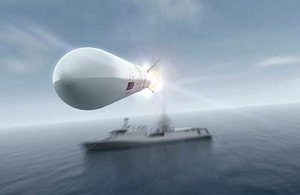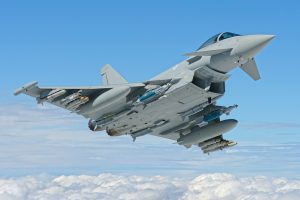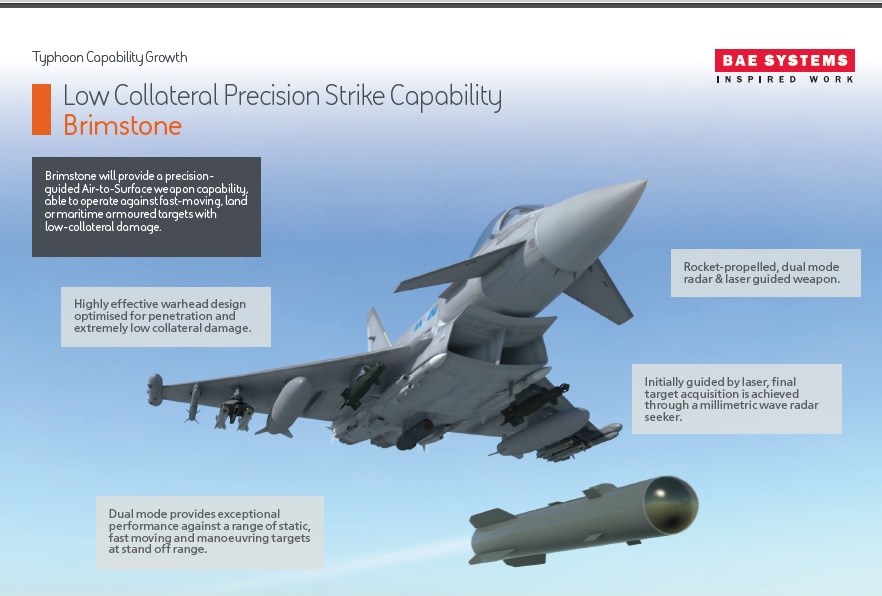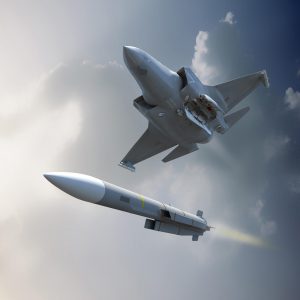2017-04-22 Recently, the UK Ministry of Defence announced new investments in new missile systems for its defense force.
In an article published on the UK MoD website, on April 21, 2017:
Secretary of State, Sir Michael Fallon, has today announced three new missile contracts worth a combined £539 million for state-of-the-art Meteor, Common Anti-air Modular Missile (CAMM) and Sea Viper missile systems at MBDA Stevenage.
The deal ensures our Armed Forces have the best equipment available to protect the new Queen Elizabeth Class Carriers and the extended fleet from current and future threats.
The half a billion-pound contracts will sustain over 130 jobs with MBDA in the UK, with missile modification and service support being carried out in Stevenage, Henlow, Bristol and Bolton.

Secretary of State, Sir Michael Fallon, said:
“This substantial investment in missile systems is vital in protecting our ships and planes from the most complex global threats as our Armed Forces keep the UK safe.
“Backed by our rising Defence budget, these contracts will sustain high skilled jobs across the UK and demonstrate that strong defence and a strong economy go hand in hand.”
As part of a £41 million contract, the Meteor air-to-air missiles will arm the UK’s F-35B Lightning II squadrons.
It will provide the Royal Air Force and Royal Navy with a world beating missile that can engage with targets moving at huge speed and at a very long range.
The weapon will enter service on Typhoon with the RAF in 2018 and the F-35B from 2024, and will be used on a range of missions including protecting the Queen Elizabeth Class Carriers.
Meanwhile, a £175 million in-service support contract for the anti-air Sea Viper weapon system will ensure that the Royal Navy’s Type 45 Destroyers can continue to provide unparalleled protection from air attack to the extended fleet. Under the contract, the missiles will be maintained, repaired and overhauled as and when required to ensure continued capability.
The Sea Viper missile defends ships against multiple threats, including missiles and fighter aircraft.
The final contract is a £323 million deal to purchase the next batch of cutting-edge air defence missiles for the British Army and Royal Navy, offering increased capability at a lower cost. Designed and manufactured by MBDA UK at sites in Bolton, Stevenage and Henlow, the next-generation CAMM missile will provide the Armed Forces with missiles for use on sea and on land. CAMM has the capability to defend against anti-ship cruise missiles, aircraft and other highly sophisticated threats.
Signalling our continued investment in Type 26 programme, CAMM will provide the anti-air defence capability on the new Type 26 Frigates for the Royal Navy and will also form part of the Sea Ceptor weapon system on the Type 23 Frigate and will also enhance the British Army’s Ground Based Air Defence capability by replacing the in-service Rapier system.
Tony Douglas, Chief Executive Officer of Defence Equipment and Support, the MOD’s procurement organisation, said:
“Work on these cutting-edge missiles, which will help to protect the UK at home and abroad and secure jobs across the country, demonstrates the importance of Defence investment. That is why, working closely with our industry partners, we continue to drive innovation and value into everything we do; securing next generation equipment for our Armed Forces at the best possible value for the taxpayer.”
Dave Armstrong, Managing Director of MBDA UK, added:
“MBDA is delighted by the continued trust placed in us by the Ministry of Defence and the British military.
“The contracts announced today for Meteor, CAMM and Sea Viper will help protect all three UK Armed Services, providing them with new cutting-edge capabilities and ensuring their current systems remain relevant for the future.
“They will also help to secure hundreds of high-skilled people at MBDA UK and in the UK supply chain, maintaining the UK’s manufacturing base and providing us with a platform for exports.”
And in a March 13, 2017 press release from MBDA, progress in the integration of a key Tornado weapon with the Typhoon was highlighted.
A further series of flight trials of Eurofighter Typhoon with the low-collateral, high precision MBDA Brimstone air-to-surface weapon have been successfully completed at BAE Systems’ site in Warton, Lancashire.
The trials are part of ongoing development work on the Phase 3 Enhancement (P3E) package for Typhoon, which will also deliver further sensor and mission system upgrades as part of Project CENTURION – the programme to ensure a smooth transition of Tornado capabilities on to Typhoon for the Royal Air Force by the end of 2018.

The trials were conducted using the UK Typhoon Instrumented Production Aircraft (IPA) 6, and formed part of work to gather air data on the weapon and expand the carriage envelope. Firing trials are now scheduled for later this year to test the effectiveness of the weapon in operational scenarios.
The flight trials, an important milestone on the integration programme following the completion of ground testing and initial flight trials last year, were partly carried out through a Combined Testing Team (CTT) approach with pilots from the Royal Air Force’s 41(R) Squadron (the RAF’s Test and Evaluation Squadron).
In total around 40 trials to integrate Brimstone with Typhoon have seen the aircraft flown with four AMRAAM, two ASRAAM, two Paveway IV laser guided/GPS bombs and two launchers each containing three Brimstone missiles.
Eight of the 40 flights have been carried out with 41(R) Squadron.
Steve Formoso, Chief Test Pilot for BAE Systems Military Air & Information business, said: “This series of flight trials has included Aero Data Gathering (ADG) flights to test how the addition of the Brimstone weapon and other assets interacts with the aircraft’s flight control system software. The results have been excellent, with the pilot maintaining manoeuvrability whilst carrying a heavy weapons load.
“The detailed results of these trials will now be analysed and further testing carried out ahead of firing trials. The low-collateral Brimstone will provide the Typhoon pilot with the ability to precisely attack fast-moving targets at range, further enhancing the aircraft’s already potent air-to-surface capabilities.”
James McLaughlin, BAE Systems’ Contract Delivery Manager for Typhoon Phase 3 Enhancements, added: “This continues to be an incredibly productive time for Typhoon development and the benefits of the Combined Testing Team approach are clearly visible.

“The dedicated work of our teams and partner companies has ensured we have been able to conduct a large number of flight trials in a short space of time, involve the Royal Air Force within the process and reach an important milestone on the Brimstone integration programme.”
The flight trials programme for Brimstone is running alongside ongoing Typhoon development programmes with the Meteor and Storm Shadow weapons, which form part of the aircraft’s Phase 2 Enhancement (P2E) package due to be delivered into service in 2018.
The CTT approach is designed to allow 41(R) Squadron to participate in early versions of planned upgrades, providing feedback that can be assessed and directly worked back into the design process, ensuring with an end product which meets Royal Air Force requirements.
And progress with regard to Meteor integration on board the F-35 was announced with a press release from MBDA dated April 21, 2017.
The United Kingdom (MOD) has today awarded MBDA a contract to pave the way for the integration of the Meteor Beyond Visual Range Air-to-Air Missile (BVRAAM) on its new F-35 stealth fighters.
 The Meteor being fired by F-35B. Image credited to MBDA.
The Meteor being fired by F-35B. Image credited to MBDA.
Today’s contract helps de-risk the integration effort and includes the mixture of test assets, productionisation and engineering work needed to support Meteor’s compatibility and use from F-35. This is excellent news for the UK’s F-35 Lightning II force, which is planned to be armed with the game-changing Meteor missile in the 2020s.
The test assets being contracted today encompass the usual suite of test missiles required for an aircraft integration programme. Contract scope also includes the role change kits for the UK’s common Meteor stockpile for both Typhoon and Lightning.
Today’s contract follows-on from the successful firing trials of MBDA’s Advanced Short Range Air-to-Air Missile (ASRAAM) from the F-35 earlier this year. ASRAAM is being integrated onto the F-35 as part of the aircraft’s Block 3 SDD programme.
Also set for future integration onto the F-35 is MBDA’s SPEAR precision surface attack missile. Meteor and SPEAR are advanced weapons that complement the ‘5th gen’ F-35, bringing networked capability with stand-off – both weapons are key elements of the UK’s carrier strike capability in the future.
http://www.mbda-systems.com/press-releases/meteor-integration-f-35-takes-significant-step-forward/

